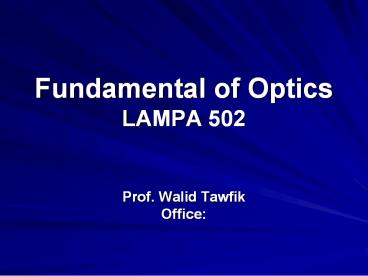Optics - PowerPoint PPT Presentation
Title:
Optics
Description:
Fundamental of optics – PowerPoint PPT presentation
Number of Views:63
Title: Optics
1
Fundamental of OpticsLAMPA 502
- Prof. Walid Tawfik
- Office
2
Course reference
- Introduction to Optics, F. L. Pedrotti
3
Course Information
- Grading
- ASSIG 5
- Attendance 5
- Mid EX1 30
- Final Test 60
- total 100
4
Course content sequence
Week Topic Lecture Exercises Practical
1 Introduction to geometrical optics 2 - -
2 The ray approximation in the ray optics 2 - -
3 Mathematical treatment of some optical phenomena such as reflection and refraction 2 - -
4 Huygenss Principle 2
5 Dispersion 2
6 Total Internal Reflection 2
7 Fundamentals of wave optics 2 - -
8 Theoretical formulation of wave superposition Term paper exam 2 - -
9 Introduction to diffraction patterns 2 - -
10 Theoretical formulation of Diffraction Patterns from Narrow Slits and Resolution of Single-Slit and Circular apertures Mid-term Exam 2
11 Theoretical formulation and conditions for wave interference from single and double slits (Youngs experiment) 2 - -
12 Introduction to polarization of light and its applications 2 - -
13 Applications of diffraction of light 2
14 Applications interference of light 2
Total 28
5
Nature of Light
6
Nature of Light
- Particle
- Isaac Newton (1642-1727)
- Optics
- Wave
- Huygens (1629-1695)
- Treatise on Light (1678)
- Wave-Particle Duality
- De Broglie (1924)
7
Young, Fraunhofer and Fresnel(1800s)
- Light as waves!
- Interference
- Thomas Youngs (1773-1829) double slit experiment
- see http//members.tripod.com/vsg/interf.htm
- Diffraction
- Fraunhofer (far-field diffraction)
- Augustin Fresnel (1788-1827) (near-field
diffraction polarization) - Electromagnetic waves
- Maxwell (1831-1879)
8
Max Plancks Blackbody Radiation (1900)
- Light as particles
- Blackbody absorbs all wavelengths and
conversely emits all wavelengths - The observed spectral distribution of radiation
from a perfect blackbody did not fit classical
theory (Rayleigh-Jeans law) ? ultraviolet
catastrophe
9
(No Transcript)
10
(No Transcript)
11
(No Transcript)
12
Cosmic black body background radiation, T 3K.
13
Plancks hypothesis (1900)
- To explain this spectra, Planck assumed light
emitted/absorbed in discrete units of energy
(quanta), - E n h??
- Thus the light emitted by the blackbody is,
14
Luis de Broglies hypothesis (1924)
- Wave and particle picture
- Postulated that all particles have associated
with them a wavelength,
- For any particle with rest mass mo, treated
relativistically,
15
Photons and de Broglie
- For photons mo 0
- E pc
- Since also E hf
- But the relation c ?ƒ is just what we expect
for a harmonic wave
16
(No Transcript)
17
(No Transcript)
18
(No Transcript)
19
Wave-particle duality
- All phenomena can be explained using either the
wave or particle picture - Usually, one or the other is most convenient
- In OPTICS we will use the wave picture
predominantly
20
Propagation of light Huygens Principle (Hecht
4.4.2)
- E.g. a point source (stone dropped in water)
- Light is emitted in all directions series of
crests and troughs
21
Terminology
- Spherical waves wave fronts are spherical
- Plane waves wave fronts are planes
- Rays lines perpendicular to wave fronts in the
direction of propagation
Planes parallel to y-z plane
22
Huygens principle
- Every point on a wave front is a source of
secondary wavelets. - i.e. particles in a medium excited by electric
field (E) re-radiate in all directions - i.e. in vacuum, E, B fields associated with wave
act as sources of additional fields
23
Huygens wave front construction
Construct the wave front tangent to the wavelets
What about r direction? See Bruno Rossi Optics.
Reading, Mass Addison-Wesley Publishing Company,
1957, Ch. 1,2 for mathematical explanation
24
Plane wave propagation
- New wave front is still a plane as long as
dimensions of wave front are gtgt ? - If not, edge effects become important
- Note no such thing as a perfect plane wave, or
collimated beam































